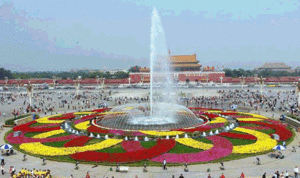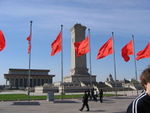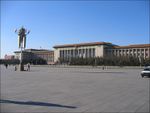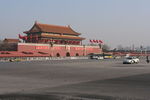Green Infrastructure 2014 Working Group G - Case Study 1
---> back to group page working group G
'''Tiananmen Square'''
| Name | Tiananmen Square | |
| Country | China | |
| City | Beijing | |
| Authors | Majid Amani Beni | |

| ||
|
| ||
Rationale: Why is this case interesting?
Tiananmen Square is an outstanding designed landscape in the city Beijing (Capital of China).Its location in the heart of the city, presence of surrounding symbolic eloquent infrastructure, easily access for common and general people, road pattern of surrounding areas and existing landscape features and its Green Infrastructures make Tiananmen Square a famous and prominent urban plaza. Tiananmen Square is not only the urban plaza but also an example of great aesthetical view in China.
Green Infrastructures in Tiananmen Square consist of flower gardens, trees and water bodies (water bodies can be considered as green Infrastructures). flower gardens include two lots in the Tiananmen Square full of colorful flowers. Trees can be seen in some parts of the squire specially at the side of the Chairman Mao’s Memorial Hall.
There is a water body outside of the square and at the middle point of the square of the Forbidden City. It is also a natural resource which can be classified as the green Infrastructures of the landscape of the Tiananmen Square.
Author's perspective
in previous part it is mentioned that Tiananmen Squire, is a famous place in Beijing. Almost of tourists who travel to china, wish to visit this squire that located in the heart of city Beijing. Also it is an everyday landscape for lots of citizens. As i am new comer student in Beijing and my background is Horticulture (Floriculture) and green space science, when I visited the squire, I asked myself how its possible to put green infrastructures to make a better landscape in this site? Is there any problem with regard to current situation of the squire? How it could be solved?
Landscape and/or urban context of your case
Tiananmen Square is a large city square in the center of Beijing, China, named after the Tiananmen gate (Gate of Heavenly Peace) located to its North, separating it from the Forbidden City. Tiananmen Square is the fourth largest city square in the world (440,000 m2 – 880×500 m or 109 acres – 960×550 yd). It has great cultural and historical significance as it was the site of several important events in Chinese history.
The squire is generally considered as an urban plaza or urban center. People from regions of china and also from different countries come to visit it for its great architectural, ideological & historical significance.
This famous squire has different landscape elements as below:
NATURAL ELEMENTS
Natural elements in the Square consists of flower gardens and trees that mentioned in first section of this webpage.
IDEOLOGICAL ELEMENTS:
Chairman Mao’s Memorial Hall: Mao Zedong Memorial Hall is the Tomb-site for China's Father of the Nation, the longtime Chairman & Secretary of the Chinese Communist Party, Mao Zedong. The Mausoleum building in itself is a strange mix of 1950's Stalinist architecture and some unclear hints of European and Chinese styles. It was constructed shortly after the death of Mao Zedong in September 1976 AD. Today Mao Zedong Memorial Hall is one of the Top Attractions to visit on the Square, especially for Chinese citizens.
CULTURAL ELEMENTS:
Monument of Peoples’ Heroes: It is Established on April 22, 1958, Monument to People's Heroes lies in the center of the square. It was built for Celebration of the heroes who died in the Chinese People's War for Liberation and the Chinese People's Revolution.
Quianmen Gate: Quianmen (or Zhengyang Men) is one of nine gates that lead to the imperial quarters in the Forbidden City. It is located on the south side of Tiananmen Square.
National Museum of China: It is located in the eastern side of Tiananmen Square. The building was one of ten famous architectures built in 1959 to mark the 10th anniversary of the founding of the People's Republic.
Great Hall of the People: The Great Hall of the People is located at the western edge of the square. It is a modern structure and interesting for people and especially architects.
Tiananmen Gate: The Tiananmen, Tian'anmen or Gate of Heavenly Peace is a famous monument in Beijing. It is widely used as a national symbol.
Lampposts: Lampposts are located in the pavement of Tiananmen Square. These Lampposts represents Chinese culture and history along with their architecture.
- Illustrations
Analytical drawings
Some problems can be seen in this famous square. The most important problem is the low ratio of green infrastructures and natural elements in the site. It seems that if enough green infrastructure be put in the square, the landscape will be more eye-caching. Also there are other problems like the lack of sitting place for tourists and bad placement of security cameras. The security cameras is placed exactly under the Lampposts which have cultural and antithetical values. This bad placement makes disturbance in the view for Lampposts).
- Analytical Drawings
Green Infrastructure benefits for this site
As it mentioned, The most important problem in this site, is the low ratio of green infrastructures and natural elements. It is believed that if some green infrastructure and natural elements be added and also if cultural and ideological elements of the site be connected together via natural elements, the landscape will be much richer and aesthetic.
Adding green infrastructure to this site have many advantages, not only for aesthetical purposes but also for increasing ecological role and habit diversity of this large urban site. adding green infrastructure makes this outstanding landscape more “natural“ and “people friendly“unique, interesting and representative for both Beijing’s residents as well as tourists.
However in the process of adding green infrastructure, for example in the process of planting design, some ecological principles should be considered. Applying the ecological principles will cause more sustainable landscape.
Potential for multifunctionality
Green infrastructure potentially can increase in:
Aesthetic values (Antithetical values of GI in itself and also connecting different elements of the site)
Ecological role
Tourism attraction
Habit diversity
Sustainability
Projective drawings
- How would you like this case to change in the near future? (in 1-2 years)
- you may add a short explanation here
- And how could it look like in 10-15 years?
- you may add a short explanation here
- Projective Drawings
- Yourdrawing.jpg
projective drawing
- Yourdrawing.jpg
projective drawing
- Yourdrawing.jpg
projective drawing
- Yourdrawing.jpg
projective drawing
Summary and conclusion
Tiananmen Square is a great example of designed and planned landscape. The location of the square in the heart of the city (Beijing, capital of China), presence of different cultural, ideological and historical elements, road pattern around the square and accessibility for people, make this square a famous and dominant urban places and tourist attraction site not only in the China but also in the world.
In the viewpoint of greening structure, the most important problem in this site, is low ratio of green infrastructures and natural elements in this site. It is believed that adding green infrastructure makes this outstanding landscape more natural, people friendly and representative for both Beijing’s residents as well as tourists. The advantages of the adding more green infrastructure to this site are increasing the aesthetic values, ecological role and habit diversity of this large urban site.
Image Gallery
- Image Gallery
References
- please add your references here
About categories: You can add more categories with this tag: "", add your categories










